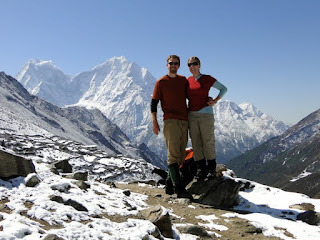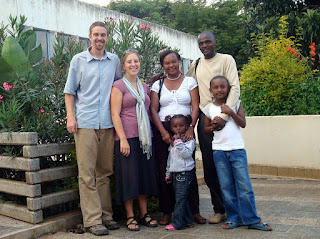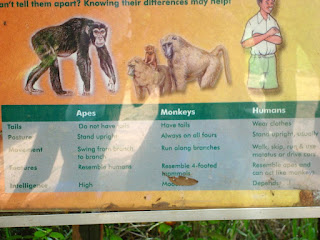These buildings make up one side of the Yatkha Bahal, a large courtyard just south of the touristy Thamel area of Kathmandu. The little 4-storey guy wedged between his bigger neighbors was one of our favorite sites in Kathmandu.
The area of Kathmandu known as Asan Tole is a thriving market most days. Appropriately, the Annapurna Temple, in the background of this photo, is dedicated to the goddess of abundance. We were told the faithful make offerings here by circling the temple, touching a coin to their head before throwing it into the temple, and then ringing a bell.
Feeding the pigeons in the courtyard surrounding Seto Machhendranath temple can be good for one's karma. This temple is important to both Hindus and Buddhists.
In the square of the Kathesimbhu Stupa, we noticed this little girl playing on a small stupa.
In front of a temple in the Indra Chowk area of Kathmandu, this intersection is a mix of pedestrians, motorbikes, bicycles, rickshaws and Suzuki hatchback taxis...oh, and a pile of rubbish.
Like we said, Kathmandu is vibrant. The presence of so many religious temples, shrines, and statues mixed in with every day life continued to delight us here in Kathmandu. Similar to Southeast Asia, it was very common to come across a 600-year old Buddha ensconced into a street-side wall. To purposefully seek out a Buddhist religious site, we headed 11-km northeast of the city's center to Boudhanath. This massive stupa dominates the skyline and dwarfs the 5-storey buildings that surround it.
Boudhanath
At dawn and dusk, Boudhanath's faithful worship by walking clockwise around the stupa while reeciting their prayers and/or spinning the prayer wheels.
Our 12-day trek was to begin in the town of Lukla, which is northeast of Kathmandu in the Everest region. It is at 2,860 meters (9,380 ft.) and there are two ways of getting there: a 6-day hike from Jiri or a 1/2 hour plane ride. We chose the plane, so our trip begin by slamming into the uphill runway. The 12% grade helps slow the plane before the wall which is only 1700 feet away. Mind you, this landing is nothing in comparison to the take-off down the 12% grade hill.
Don't worry. That plane taking off (i.e. headed downhill) will lift off before it runs out of runway and the hill drops off 2,000 ft.
Once in Lukla, all we had to do was walk. It is definitely possible to go trekking without any assistance, but we decided that since our trip was a last minute decision we didn't want to have to deal with the logistics. We organized our trek with Nepal Mountain Trekking, and trekked with a wonderful guide, Phurba Sherpa, and a porter, Lok. If anyone is looking for a trekking company, we'd highly recommend Nepal Mountain Trekking. They are locally owned, environmentally conscious, concerned about their staff, and donate a portion of their profits back to educational programs in eastern Nepal.
Day 1: Most people of the Everest region are ethnically Sherpa. Traditionally their homes were smaller than this one in this picture, but nowadays many families have built a teahouse, or lodge, to rent rooms to tourists as they trek through.
Day 1: Dzobjok (a yak-cow hybrid) are a common "beast of burden" in the region.
Day 1: People are the most common "beast of burden," though.
Day 1: The field above, wheat, below was probably recently harvested potatoes.
Day 2: Carissa and some mountains--showing that we are finally gaining some altitude.
Day 2: The town of Namche Bazaar, at 3,440 meters (11,286 ft), is a place where many trekkers stay over two nights to acclimatize and the site of the region's major weekly market. On Fridays and Saturdays, produce and anything else you can imagine is carried here to be sold.
Day 3: First view of Mt. Everest (8,848 meters (29,029 ft)). It;s the "little" guy peaking over the ridge of Nuptse (7,861 meters (25,790 ft)). Clouds are extending to the right from it over to Lhotse (8,516 meters (27,940 ft). Also of note, Ama Dablam (6,812 meters (22,349 ft)) is to our right, which is the third most climbed peak in Nepal.
Day 3: The three kids at our teahouse watching a yak convoy roll through Khumjung (3,780 m (12,401 ft)), a town of about 2,000 people.
Day 3: The view at dusk from our bedroom window in Khumjung.
Day 4: Stupa in the town of Mong-La (3,960 m (12,992 ft)).
Day 5: Mortimer near the town of Luza (4,410 m (14,304 ft)) with Cho Oyu (8,201 m (26,906 ft)), the sixth tallest mountain in the world, in the background.
Day 6: Carissa enjoying the high altitude sunshine at about 4,450 m (14,599 ft).
Day 6: The village of Gokyo (4800 m (15,750 ft)) with Cho Oyu in the background.
Day 6: Rich and our fabulous accommodations on the shores of Lake Gokyo. The cyber cafe was fully operational, but, sadly, the pool was closed for the season.
Day 7: The beautifully frosted world at dawn--2 inches of snow that night with accompanying thunder and lightning.
Day 7: Dzobjok love the snow!
Day 7: Descending down the valley from Gokyo, the snow is melting fast.
Day 7: The Dudh Koshi River.
Day 7: Arriving at the village of Thare (4,300 m (14,107 ft). Our teahouse, this night, was above a yak barn. Domestic yaks are kept primarily as "beasts of burden" and for their milk, fiber, and meat. Dried yak dung is an important fuel throughout this region. It was burned in the stoves of most of the teahouses we stayed in for heat.
Day 8: Another two inches of snow over the night with thunder and lightning again.
Day 8: The village of Thore (4,390 m (14,402 ft)).
Day 8: Carissa really became enamored with yak calves during the trip. Rich had to convince her they would not make good house pets.
Day 8: Yaks in all their glory in the village of Thore.
After we visited Gokyo and climbed to a height of 5,075 m (16,650 ft), we began our descent back towards Lukla on Day 7. We enjoyed these days very much because of the scenery, the more remote route we took, and because our legs were actually tired at the end of these days. You see, as we ascended towards Gokyo it is not advised to gain more than about 300 m (~1,000 ft) per day or Altitude Sickness would be more likely. This sort of gain only translated to about 3-4 hours of hiking for us per day, so we had long afternoons exploring small villages, reading and playing cards. We are glad Phurba, our guide, kept us to this schedule because many people hike too far and hence ascend too quickly in this region. We saw quite a few people with Altitude Sickness symptoms, and 2-3 helicopters evac'ing people from the area per day.
The hike back down through Phortse, Pangboche, Tengboche, and Namche Bazaar to Lukla was a delightful resurgence of colors and smells in the world. As we descended into the rhodedendron forests, they were beginning to bloom into beautiful red, pink and white floral displays.
Once reaching Lukla, we found that the airport had been closed for two days as it was socked in with bad weather. Many frustrated tourists found themselves on waiting lists that extended days and days, so alternate plans were made by many of them to charter helicopters back to Kathmandu. We were lucky and and the next morning the weather was clear and beautiful. Our flight was not canceled, so we did not need to worry about contingency plans.
In Kathmandu, we found that the calm of the mountains was a thing of the past. The turmoil of Kathmandu's streets, that previously seemed normal to us, was now quite crazy. To add to the regular street congestion, no European tourists were able to return home as the volcano in Iceland was spewing ash across the Northern hemisphere, so the touristy Thamel area seemed to be full of even more pedestrians. We were glad we had only one day before our flights to Delhi, India, then on to Bangkok, Thailand, and then on to Melbourne, Australia to visit Rich's aunt, cousin, and her family.





















































